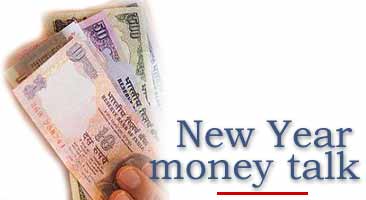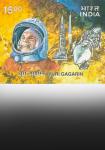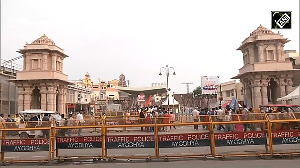
A year ago we asked a handful of corporate chieftains about their investment strategies for 2003.
We asked them to invest an imaginary corpus of Rs 50 lakh (Rs 5 million) in the best way possible. The money could be invested, depending on their choice, in everything from the stock market to mutual funds, tax saving instruments, property, gold or art.
But 2003 was a year of mind-numbing changes. Most importantly, from an investor's point of view, the stock market has soared higher than anyone expected.
So we returned to the same group of corporate chieftains to see if they had altered their investment plans to suit the swift-changing new realities in the marketplace.
And we checked out whether they would do things differently now that the stock market is on an unstoppable roll and Indian foreign exchange reserves have touched $100 billion.
Needless, to say most people are bullish on the stock market, and say they will put money both directly in the market and in mutual funds. Property continues to be a strong favourite. And those who are lovers of art feel that art is always a good buy.
It's important to remember that, when the bulls stampede through the markets, the professionals advise that the average investor should not throw caution to the winds.
To stay fairly cautious, Sanjiv Bajaj, director, Bajaj Capital recommends that anyone entering the stock market today should not invest in a lumpsum but should put money in a systematic fashion and should rebalance their portfolio between equity and debt at regular intervals.
Also, it is essential to book profits and transfer them to a debt instrument.
Bajaj also believes that commercial property is a good bet for investors.
Says Bajaj: "I personally would invest 30 per cent in equity mutual funds, 30 per cent in debt instruments such as RBI Bonds and the Post Office Monthly Income Scheme and the remaining 60 per cent in commercial and residential property."
Ranjan Kapur, President, O&M: Last year Kapur was about to buy property in Mumbai. He was convinced that no instrument offered decent returns and that property was still the best bet.
He was also convinced that property in Mumbai offered the best returns in terms of rentals. Kapur said that he always bought art even though it wasn't entirely for investment purposes.
Significantly, he wasn't going to invest in the stock market, mutual funds or even government bonds.
I still feel property is a very good investment. I bought the property I had told you about and I believe it will appreciate in value over the years. However, for me it doesn't matter as I intend to live there and the emotional appreciation is 100 per cent.
In the last year I have bought six pieces of art. I bought these because I liked them and they are all from fairly well-known artists.
I haven't got a valuation of the pieces done but have been to several exhibitions of the artists and have noticed a marginal appreciation in the prices of their work since the time I purchased my pieces from them.
In the last 6-8 months I have also been investing in equity which is a complete change from my attitude to invest last year.
A year back I felt that there was nothing worth investing in but today the scenario is completely different. So I have invested directly in the stock market and also in equity mutual funds.
In fact, I have withdrawn money from bank FDs and have put it in the stock market.
The way the market in going I feel that if people have spare funds then they should definitely look at the equity market but only after they have covered their bases with safe, solid investments.
If you consider a person's net worth over a period of time then I would say that about 20 per cent of my net worth is in property, 15 per cent is in long-term investments like RBI Bonds and 12-15 per cent is in equity.
The other half is invested in my own company's shares which I am due to get when I retire, but that's not on the market.
D K Jain, Chairman, Luxor Group: Last year Jain wanted to put 25 per cent of his money in the stock market because he felt that the market was going to gain.
He cited factors like the swelling foreign exchange kitty and that foreign investors were looking seriously at India. Also, he felt that the IT industry would continue to grow healthily. He zeroed in on the IT, pharma and banking sectors.
Besides that Jain said he would invest 25 per cent in real estate in metro cities and another 25 per cent in RBI Bonds or in PPF. He didn't want to invest in mutual funds.
Lastly, he planned to invest 10 per cent in art and 15 per cent in diamond jewellery.
I would invest 25 per cent in the stock market as it appears that the economy has revived in India and Sensex is going to be more than 6500 by December 2004.
With the economy reviving, the whole world is looking at India and bringing in their investments. Now India has foreign exchange reserves of $100 billion as on date and would be getting more in the near future, touching $150 billion by December 2004.
We are moving towards full convertibility, FDI players are looking at the Indian market worldwide. It is a safe place to invest as compared to China and Russia because of stability in political scene.
IT has a good future. I would prefer to invest in IT, pharma, steel and banking sectors.
I would invest 25 per cent in real estate in metro cities. I am reluctant to invest in mutual funds. I will invest 25 per cent in RBI bonds in PPF.
Being an art lover, I will invest 10 per cent in art and 15 per cent in diamond jewellery. The investment of 15 per cent in diamond jewellery is towards security reason of an individual family. This could be a combination of more gold and diamond jewellery.
Venugopal Dhoot, Videocon: Last year, Dhoot divided 60 per cent of his portfolio equally between the stock market (chiefly IT stocks), mutual funds, and property in metro cities. He planned to put the remaining 40 per cent in PPF, NSC, RBI Bonds and other tax-saving instruments.
My plans changed during the course of this year. As the stock market zoomed I invested nearly 40 per cent of my corpus in the stock market. The remaining 60 per cent I invested in gilt and government securities and also PPF NSC and other tax saving instruments.
In 2004, I will invest nearly 90 per cent in the stock market. I would like to go directly to the stock market instead of going through the mutual fund route. I will buy automobile and consumer durable stocks.
I feel pharmaceutical stocks have saturated and automobile/automotive components and consumer durables are likely to soar.
I'll invest 5 per cent in property and the remaining 5 per cent in bullion.
Gul Tekchandani, chief investment officer, Sun F&C: One year ago Tekchandani wanted to put 60 per cent of his money in equity and 40 per cent in debt. He said the money in the stock market would mostly be directed at topline companies in automobiles, cement, steel and technology companies.
He also felt it would be a good time to look at non-conventional investments like art.
He was planning to invest 5 per cent of the Rs 50 lakh portfolio in art and another 5 per cent in gold and said these investments would mean that his debt holdings would be reduced.
Unlike the last time, when I had said I would devote 60 per cent of the money you were allocating into equity and the remaining 40 per cent in debt, today I would invest 45 per cent in equity and the rest in debt and that too debt instruments related to banks.
The market has gone up 100 per cent in the last year and it's really a question of risk management.
If there is a slight correction then I will go back to putting 60 per cent in equity. I'm not saying the market is bad, but it has become so easy to make money on the stock markets in the last two months, that I'm afraid there is something I do not know about the market.
But I still maintain that the markets are good from a two year perspective, however, in the short term I wouldn't like to put in too much money.
I would still look at real estate. However, it's not a market for everyone simply because you have to have the necessary funds to direct to it. Also, if you are buying real estate to live in, then it's not an investment. You should be able to sell the property without incurring replacement costs.
I wouldn't buy gold this year because of the price level it is available at today. But art and its lesser known sister antiques are definitely worth looking at for high net worth individuals who have lots of investible money to spare.
However, not more than five per cent of their portfolio should be devoted to these options.
Siddhartha Lal, chief executive, Eicher: Lal is an old-fashioned investor who believes firmly in the power of property. Last year he wanted to spend Rs 50 lakh on a property situated on the outskirts of town.
The dream purchase, according to Lal (who shifted a few years ago from Delhi to Chennai) would be a well-located beach property on the East Coast Road joining Chennai and Mahabalipuram.
I would utilise the Rs 50 lakh to pay the downpayment for a property in a city. Now that housing loans are so inexpensive, it's a good idea to get a good property in one of the metros or their suburbs.
Once people have gained heavily on the stock-market, they will start putting funds in real estate and the property prices are definitely going to rise. Besides, it's more interesting to have a property than holdings in various companies -- in my books at least!
Personally, I don't follow the stock market at all (except of our own companies and competitors) and therefore don't invest in it. I did not invest in the stock market in 2003 and am not planning to invest now.







 © 2025
© 2025